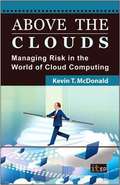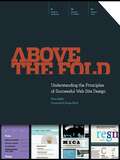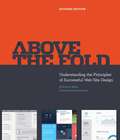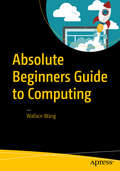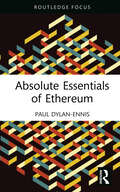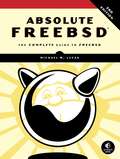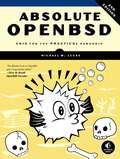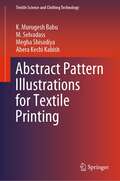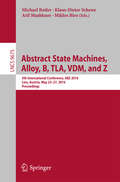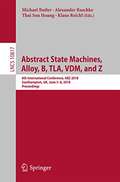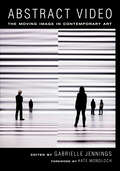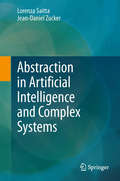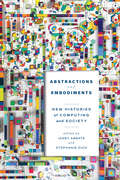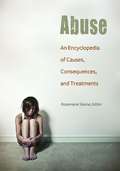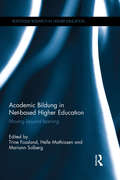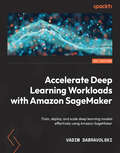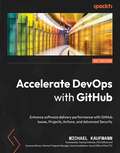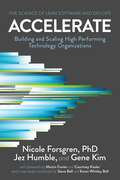- Table View
- List View
Above the Clouds: Managing Risk in the World of Cloud Computing
by Kevin T. McdonaldInterested in ways to make your business more efficient? Then Cloud Computing may be just what you have been looking for. Cloud Computing can enable you to drive down the costs of your IT function and gives you the ability to focus on your core business, whilst saving energy. The concept of shifting computing to a shared service provider is not new. What is new is that the cost of Cloud Computing is falling so dramatically that considering outsourcing to the Cloud is no longer rare. And, in an era of tight budgets, the opportunity to make financial savings means that Cloud Computing looks especially attractive. "Above the Clouds: Managing Risk in the World of Cloud Computing" acts as a primer and strategic guide to identify Cloud Computing best practices and associated risks, and reduce the latter to acceptable levels. From software as a service (SaaP) to replacing the entire IT infrastructure, the author serves as an educator, guide and strategist, from runway to getting the organization above the clouds. Valuable tips on how to choose your provider of Cloud Services are also offered. The author, Kevin T. McDonald is a Senior Information Technology Analyst and Cloud Strategist for ICF International Inc, a consulting firm in Washington, DC. A member of the Tech America Cloud Computing Committee and the Cloud Security Alliance, Kevin has over 25 years' experience in IT, choosing to specialize in cyber security, infrastructure protection and business continuity. Buy this book and take your business on a journey above the Clouds!
Above the Fold
by Brian MillerThis is a different kind of web design book. Above the Fold is not about timely design or technology trends; instead, this book is about the timeless fundamentals of effective communication within the context of web design. It is intended to help you, the reader, understand the considerations that web designers make when developing successful websites. Above the Fold is divided into three sections: Design & Typography Planning & Usability Business Value Each section represents a phase in the continuous cycle of web design. It's the balance among design, usability, and return on investment that makes a website truly great. Topics covered in Above the Fold include: What makes web design unique The history of web design Anatomy of a web page White space and grid use in web design The elements of web design: color, texture, imagery, scale, depth, animation, and variability Web typography, including web-safe type, images of type, and font replacement and embedding Web project planning Information architecture, including site maps, wireframes, and user flow diagrams The elements of usability: navigation, breadcrumbs, links, search, submission forms, and error messaging Search engine optimization Online marketing, including banner ads, viral and social marketing, on-site marketing, and email marketing Web statistics and analysis
Above the Fold, Revised Edition
by Brian D MillerAbove the Fold is a book about the fundamentals of clear graphic communication within the context of Web design. The book has three sections, which follow the cycle of a typical Web project:PLAN Section I focuses on the predesign phase of a Web project. From project planning and brief writing to information architecture and responsive grid creation.DESIGN The second section of Above the Fold explores the enduring principles of design and the nuances that are specific to the field of Web design.OPTIMIZE Finally, we close the loop and discover ways to enable your client to maximize the investment they've made in their Web site with marketing and analytics.
Above the Fold, Revised Edition
by Brian D. MillerAbove the Fold is a book about the fundamentals of clear graphic communication within the context of Web design. The book has three sections, which follow the cycle of a typical Web project:PLANSection I focuses on the predesign phase of a Web project. From project planning and brief writing to information architecture and responsive grid creation.DESIGNThe second section of Above the Fold explores the enduring principles of design and the nuances that ar
Above the Fold: Understanding the Principles of Successful Web Site Design
by Brian MillerThis is a different kind of web design book. Above the Foldis not about timely design or technology trends; instead, this book is about the timeless fundamentals of effective communication within the context of web design. It is intended to help you, the reader, understand the considerations that web designers make when developing successful websites. Above the Foldis divided into three sections: Design & Typography Planning & Usability Business Value Each section represents a phase in the continuous cycle of web design. It's the balance among design, usability, and return on investment that makes a website truly great. Topics covered inAbove the Foldinclude: What makes web design unique The history of web design Anatomy of a web page White space and grid use in web design The elements of web design: color, texture, imagery, scale, depth, animation, and variability Web typography, including web-safe type, images of type, and font replacement and embedding Web project planning Information architecture, including site maps, wireframes, and user flow diagrams The elements of usability: navigation, breadcrumbs, links, search, submission forms, and error messaging Search engine optimization Online marketing, including banner ads, viral and social marketing, on-site marketing, and email marketing Web statistics and analysis
Above the Fold: Understanding the Principles of Successful Web Site Design
by Brian MillerThis is a different kind of web design book. Above the Fold is not about timely design or technology trends; instead, this book is about the timeless fundamentals of effective communication within the context of web design. It is intended to help you, the reader, understand the considerations that web designers make when developing successful websites.Above the Fold is divided into three sections:Design & TypographyPlanning & UsabilityBusiness Value Each section represents a phase in the continuous cycle of web design. It's the balance among design, usability, and return on investment that makes a website truly great.Topics covered in Above the Fold include:What makes web design uniqueThe history of web designAnatomy of a web pageWhite space and grid use in web designThe elements of web design: color, texture, imagery, scale, depth, animation, and variabilityWeb typography, including web-safe type, images of type, and font replacement and embeddingWeb project planningInformation architecture, including site maps, wireframes, and user flow diagramsThe elements of usability: navigation, breadcrumbs, links, search, submission forms, and error messagingSearch engine optimizationOnline marketing, including banner ads, viral and social marketing, on-site marketing, and email marketingWeb statistics and analysis
Abschlussarbeiten mit LaTeX erstellen: Eine Einführung für Ingenieure, Informatiker und Naturwissenschaftler
by Marcel Müller Elmar WingsDieses Buch vermittelt die Grundlagen und das notwendige Spezialwissen, das zum Schreiben von wissenschaftlichen Abschlussarbeiten mit LaTeX erforderlich ist. Das schließt Bachelor- und Masterarbeiten sowie Dissertationen ein. Es eignet sich aber auch für die ersten Laborberichte, Studien- und Seminararbeiten.Der Leser lernt die Funktionsweise von LaTeX und diverse Werkzeuge kennen. Zur Wissensvermittlung werden Quelltextbeispiele verwendet. Übungsaufgaben und Kontrollfragen am Ende der Kapitel helfen beim Vertiefen des Erlernten. Verweise auf weiterführende Literatur und auf die jeweiligen Paketbeschreibungen unterstützen den Leser dabei, sein Wissen über den Inhalt dieses Buches hinaus zu erweitern.Das Ziel dieses Buches ist es, den Leser dahingehend zu befähigen, dass er effizient eine wissenschaftliche Abschlussarbeit in hoher typografischer Qualität mit LaTeX anfertigen kann, wenig Zeit in das Formatieren investieren muss und fokussiert am Inhalt arbeiten kann.
Absolute Beginners Guide to Computing
by Wallace WangLearn and understand how you can perform a wide range of tasks on your new Windows computer, including managing files, browsing the internet, and protecting yourself, as well as interacting with Cortana. Using Absolute Beginners Guide to Computing you will see how to use Windows, and how you can connect and communicate with others. You will learn the basics of browsing the web, how to send email, and sign up for services. You will learn about some of the social media sites such as Facebook and Twitter. You will also learn how to connect and use external hardware, and process digital music, photos, and video. Written by an author who has written multiple computing titles, this book is friendly and approachable, and can teach anyone how to use a computer. With simple steps, easy troubleshooting, and online resources, it's the best place to learn how to make computing a part of your life. What You'll Learn: Get pictures onto your computer to share Listen to digital music What clubs, groups, and other resources there are to help Who this Book Is For Anyone that wants to learn all the latest Windows features. Beginners who want to use their new Windows computer to share pictures or video clips on YouTube or Facebook to those seeking a common sense approach to safe computing.
Absolute Essentials of Digital Marketing (Absolute Essentials of Business and Economics)
by Alan CharlesworthThis short form textbook provides readers with a comprehensive yet concise overview of the fundamentals of Digital Marketing. The author, a well-renowned teacher and writer on the subject, presents a concise and clear structure that works step by step through each of the core aspects of the subject, including SEO, metrics and analytics, web development, e-commerce, social media and digital marketing strategy. Presented in nine chapters to suit delivery periods at both undergraduate and postgraduate levels, this book can be used either as a core text that gives tutors a sound platform on which to structure a module on digital marketing or as supporting text where digital marketing is an element of a module with a broader scope, such as strategic marketing. Pedagogical features include an essential summary paragraph at the start of each chapter, focused references and further reading. There is also online teaching and learning support for both in-class and digital delivery, including suggested case studies, chapter questions and other activities.
Absolute Essentials of Ethereum (Absolute Essentials of Business and Economics)
by Paul Dylan-EnnisAbsolute Essentials of Ethereum is a concise textbook which guides the reader through the fascinating world of the emerging Ethereum ecosystem, from the basics of how its blockchain works to cutting-edge applications.Written by an experienced educator, each chapter is designed to progress potential students from class to class. Technical concepts are clearly explained for those new to the topic and readers are supported with definitions and summaries in each chapter. Real-life case studies situate the overviews in a contemporary context. Topics covered include the Ethereum Execution and Consensus layers, Ethereum governance and community, Decentralised Autonomous Organisations (DAOs), Decentralised Finance (DeFi), Non-Fungible Tokens (NFTs) and Layer 2.This book is the ideal text to support undergraduate and postgraduate courses on blockchain technologies, cryptocurrencies, Web3 and fintech, as well as for those who want to know how Ethereum really works.
Absolute FreeBSD, 3rd Edition: The Complete Guide to FreeBSD
by Michael W. LucasThis updated edition of Michael W. Lucas' definitive volume on FreeBSD-based systems adds coverage of modern disks, the ZFS filesystem IPv6, redesigned jail and packaging systems, and virtualization, among dozens of new features added in the last 10 years.FreeBSD is the muscle behind companies like Netflix and EMC. Any place where someone does heavy lifting on the Internet, you'll find FreeBSD. This newly revised edition of Absolute FreeBSD brings FreeBSD's strengths to bear on your problems and covers FreeBSD's newest features, all in the inimitable style that has made author Michael W. Lucas' system administration books so popular.Any computer system is only as good as the system administrator's knowledge. Absolute FreeBSD teaches you everything you need to know about managing FreeBSD systems, from installation, configuration, and taking the system from "just working" to "working well." A cohesive focus on service delivery and best practice means that you can apply much of the book to other operating systems.Absolute FreeBSD dives deep into server management, taking you beyond just making things work and into understanding why they work.You'll learn: * How to best install FreeBSD to meet your needs * Which filesystem to use in your environment * How to back up and restore critical data * How to tweak the kernel, and when not to * Network configuration, from activating interfaces to selecting congestion control algorithms * How to manage UFS, ZFS, and other critical filesystems * FreeBSD's software packaging system, including how to build your own package repository * How and when to upgrade * Techniques to build your own FreeBSD * Advanced security features like blacklistd and packet filtering * How to monitor and adjust performance * Container-style virtualization with jails * Diskless systems * Panic management and bug reportingWith Absolute FreeBSD readers will get the solid introduction they need while fans of the earlier editions will expand their skills even further.
Absolute OpenBSD, 2nd Edition: Unix for the Practical Paranoid
by Michael W. LucasOpenBSD, the elegant, highly secure Unix-like operating system, is widely used as the basis for critical DNS servers, routers, firewalls, and more. This long-awaited second edition of Absolute OpenBSD maintains author Michael Lucas's trademark straightforward and practical approach that readers have enjoyed for years. You'll learn the intricacies of the platform, the technical details behind certain design decisions, and best practices, with bits of humor sprinkled throughout. This edition has been completely updated for OpenBSD 5.3, including new coverage of OpenBSD's boot system, security features like W^X and ProPolice, and advanced networking techniques.You'll learn how to: –Manage network traffic with VLANs, trunks, IPv6, and the PF packet filter–Make software management quick and effective using the ports and packages system–Give users only the access they need with groups, sudo, and chroots–Configure OpenBSD's secure implementations of SNMP, DHCP, NTP, hardware sensors, and more–Customize the installation and upgrade processes for your network and hardware, or build a custom OpenBSD releaseWhether you're a new user looking for a complete introduction to OpenBSD or an experienced sysadmin looking for a refresher, Absolute OpenBSD, 2nd Edition will give you everything you need to master the intricacies of the world's most secure operating system.
Abstract Pattern Illustrations for Textile Printing (Textile Science and Clothing Technology)
by K. Murugesh Babu M. Selvadass Megha Shisodiya Abera Kechi KabishThis book is intended for textile designers, fashion designers, and for those interested in the integration of graphic design with textile surface printing. The book discusses how abstract graphic designs with intense color palette range work on different types of fabrics, will be beneficial for designers. The book provides beautiful illustrations of abstract designs that can be used directly for textile printing and also acts as inspiration (or motivation) for development of new designs. Abstract designs represent an accurate depiction of a visual reality and uses shapes, colors and forms to achieve its effect. This book provides illustrations that show the importance of color and color combinations with bright, warm and dull colors. The book presents flawless illustrations with great harmony between the diverse shapes and overall color combinations. All the illustrations in this book are explained briefly. The illustrations can also be used in other areas like wall paper design, packaging design, ceramic design and many more.
Abstract State Machines, Alloy, B, TLA, VDM, and Z: 5th International Conference, ABZ 2016, Linz, Austria, May 23-27, 2016, Proceedings (Lecture Notes in Computer Science #9675)
by Michael Butler Klaus-Dieter Schewe Atif Mashkoor Miklos BiroThis bookconstitutes the refereed proceedings of the 5th International Conference on AbstractState Machines, Alloy, B, TLA, VDM, and Z, ABZ 2016, held in Linz, Austria, inMay 2016. The 17 full and 15 short papers presented in this volume were carefullyreviewed and selected from 61 submissions. They record the latest researchdevelopments in state-based formal methods Abstract State Machines, Alloy, B,Circus, Event-B, TLS+, VDM and Z.
Abstract State Machines, Alloy, B, TLA, VDM, and Z: 5th International Conference, Abz 2016, Linz, Austria, May 23-27, 2016, Proceedings (Lecture Notes in Computer Science #9675)
by Michael Butler Atif Mashkoor Miklos Biro Laus-Dieter ScheweThis book constitutes the refereed proceedings of the 5th International Conference on Abstract State Machines, Alloy, B, TLA, VDM, and Z, ABZ 2016, held in Linz, Austria, in May 2016. <P><P> The 17 full and 15 short papers presented in this volume were carefully reviewed and selected from 61 submissions. They record the latest research developments in state-based formal methods Abstract State Machines, Alloy, B, Circus, Event-B, TLS+, VDM and Z.
Abstract Video: The Moving Image in Contemporary Art
by Gabrielle JenningsOffering historical and theoretical positions from a variety of art historians, artists, curators, and writers, this groundbreaking collection is the first substantive sourcebook on abstraction in moving-image media. With a particular focus on art since 2000, Abstract Video addresses a longer history of experimentation in video, net art, installation, new media, expanded cinema, visual music, and experimental film. Editor Gabrielle Jennings—a video artist herself—reveals as never before how works of abstract video are not merely, as the renowned curator Kirk Varnedoe once put it, "pictures of nothing," but rather amorphous, ungovernable spaces that encourage contemplation and innovation. In explorations of the work of celebrated artists such as Jeremy Blake, Mona Hatoum, Pierre Huyghe, Ryoji Ikeda, Takeshi Murata, Diana Thater, and Jennifer West, alongside emerging artists, this volume presents fresh and vigorous perspectives on a burgeoning and ever-changing arena of contemporary art.
Abstraction in Artificial Intelligence and Complex Systems
by Jean-Daniel Zucker Lorenza SaittaAbstraction is a fundamental mechanism underlying both human and artificial perception, representation of knowledge, reasoning and learning. This mechanism plays a crucial role in many disciplines, notably Computer Programming, Natural and Artificial Vision, Complex Systems, Artificial Intelligence and Machine Learning, Art, and Cognitive Sciences. This book first provides the reader with an overview of the notions of abstraction proposed in various disciplines by comparing both commonalities and differences. After discussing the characterizing properties of abstraction, a formal model, the KRA model, is presented to capture them. This model makes the notion of abstraction easily applicable by means of the introduction of a set of abstraction operators and abstraction patterns, reusable across different domains and applications. It is the impact of abstraction in Artificial Intelligence, Complex Systems and Machine Learning which creates the core of the book. A general framework, based on the KRA model, is presented, and its pragmatic power is illustrated with three case studies: Model-based diagnosis, Cartographic Generalization, and learning Hierarchical Hidden Markov Models.
Abstractions and Embodiments: New Histories of Computing and Society (Studies in Computing and Culture)
by Janet Abbate and Stephanie DickCutting-edge historians explore ideas, communities, and technologies around modern computing to explore how computers mediate social relations.Computers have been framed both as a mirror for the human mind and as an irreducible other that humanness is defined against, depending on different historical definitions of "humanness." They can serve both liberation and control because some people's freedom has historically been predicated on controlling others. Historians of computing return again and again to these contradictions, as they often reveal deeper structures.Using twin frameworks of abstraction and embodiment, a reformulation of the old mind-body dichotomy, this anthology examines how social relations are enacted in and through computing. The authors examining "Abstraction" revisit central concepts in computing, including "algorithm," "program," "clone," and "risk." In doing so, they demonstrate how the meanings of these terms reflect power relations and social identities. The section on "Embodiments" focuses on sensory aspects of using computers as well as the ways in which gender, race, and other identities have shaped the opportunities and embodied experiences of computer workers and users. Offering a rich and diverse set of studies in new areas, the book explores such disparate themes as disability, the influence of the punk movement, working mothers as technical innovators, and gaming behind the Iron Curtain. Abstractions and Embodiments reimagines computing history by questioning canonical interpretations, foregrounding new actors and contexts, and highlighting neglected aspects of computing as an embodied experience. It makes the profound case that both technology and the body are culturally shaped and that there can be no clear distinction between social, intellectual, and technical aspects of computing. Contributors: Janet Abbate, Marc Aidinoff, Troy Kaighin Astarte, Ekaterina Babinsteva, André Brock, Maarten Bullynck, Jiahui Chan, Gerardo Con Diaz, Liesbeth De Mol, Stephanie Dick, Kelcey Gibbons, Elyse Graham, Michael J. Halvorson, Mar Hicks, Scott Kushner, Xiaochang Li, Zachary Loeb, Lisa Nakamura, Tiffany Nichols, Laine Nooney, Elizabeth Petrick, Cierra Robson, Hallam Stevens, Jaroslav Švelch
Abuse: An Encyclopedia Of Causes, Consequences, And Treatments
by Rosemarie SkaineAbuse, a key theme of health education curricula, is also a major issue faced by many segments of society. Intended for high school students as well as undergraduates and the general reader, this comprehensive encyclopedia explores abuse in all its forms--physical, sexual, emotional, and verbal--among a variety of age and demographic groups from children to the elderly to the disabled. It sheds light on causes and symptoms of abuse, examines lasting impacts, and suggests avenues for prevention and treatment. <P><P> Specific topics of concern to a secondary school audience include bullying and cyberbullying; abuse of those in same-sex relationships; and sexual abuse through rape, date rape, incest, and sexting. Elder abuse, which has become of greater concern as our society ages, is covered, as are domestic abuse, child abuse, and abduction. Through up-to-date entries by expert contributors, readers will learn about the causes and results of specific types of abuse, as well as their legal and sociological dimensions. The title will also serve as a gateway to further study--and as a resource for readers seeking help.
Abusing the Internet of Things: Blackouts, Freakouts, and Stakeouts
by Nitesh DhanjaniThis book is a marvellous thing: an important intervention in the policy debate about information security and a practical text for people trying to improve the situation.— Cory Doctorowauthor, co-editor of Boing BoingA future with billions of connected "things" includes monumental security concerns. This practical book explores how malicious attackers can abuse popular IoT-based devices, including wireless LED lightbulbs, electronic door locks, baby monitors, smart TVs, and connected cars.If you’re part of a team creating applications for Internet-connected devices, this guide will help you explore security solutions. You’ll not only learn how to uncover vulnerabilities in existing IoT devices, but also gain deeper insight into an attacker’s tactics.Analyze the design, architecture, and security issues of wireless lighting systemsUnderstand how to breach electronic door locks and their wireless mechanismsExamine security design flaws in remote-controlled baby monitorsEvaluate the security design of a suite of IoT-connected home productsScrutinize security vulnerabilities in smart TVsExplore research into security weaknesses in smart carsDelve into prototyping techniques that address security in initial designsLearn plausible attacks scenarios based on how people will likely use IoT devices
Academic Bildung in Net-based Higher Education: Moving beyond learning (Routledge Research in Higher Education)
by Trine Fossland Helle Mathiasen Mariann SolbergThe explosive emergence of net-based learning in higher education brings with it new possibilities and constraints in teaching and learning environments.This edited collection considers how the concept of Academic Bildung - a term suggesting a personal educational process beyond actual educational learning - can be applied to net-based higher education. The book is drawing on Scandinavian research to address the topic from both a theoretical and practical standpoint.Chapters explore the facilitation of online courses and argue how and why universities should involve dimensions of Academic Bildung on both a strategic and technological pedagogical content level. The book is structured in three parts: Part I frames the current state of net-based learning and introduces Bildung as a concept; Part II contains a set of four case studies in Norway, Sweden and Denmark, also including a fifth study that looks at Scandinavian approaches to teaching and learning in comparison with data from the USA, the UK, Australia and Canada; Part III provides a synthesis of theories and cases to examine whether a Scandinavian orientation can be discerned. Contributions suggest that in order to address one of the fundamental functions of higher education, the ability to produce new knowledge, the Academic Bildung of the students has to be in focus. Grounded in theoretical and empirical discussion, this book will appeal to researchers and academics in the field of higher education as well as personnel who work with teaching and learning with technology, and academics interested in the question of Academic Bildung.
Academic Leadership in Engineering Education: Learnings and Case Studies from Educational Leaders Around the Globe (Lecture Notes in Networks and Systems #1097)
by Michael E. Auer Rohit Kandakatla Sushma KulkarniEngineering institutions worldwide are undergoing significant transformation as they work to adapt themselves to the learning needs of students in the 21st century, changing trends in the requirements of the industry and society, and growing concerns about issues related to sustainable development and climate change. Future engineering graduates must be equipped to tackle complex problems in society that are aligned with the United Nation’s Sustainable Development Goals (SDGs). There are increasing calls for engineering institutions to create quality learning experiences for students, enabling them to develop deeper learning skills such as critical thinking, problem-solving, life-long learning, leadership skills, and the ability to work in teams. Engineering curricula must be made multidisciplinary, innovative, and outcome-driven by integrating evidence-based pedagogies and learning mechanisms. For this to happen, academic leaders must reimagine their institutions with significant changes at the administration, governance, and leadership levels. Establishing new-age institutions that meet international accreditation standards requires dynamic academic leaders at multiple levels who can work collaboratively to achieve the vision and mission of the institution. This book is an attempt to share key learnings from academic leaders from around the world on important trends emerging in engineering education. Aspiring academic leaders will get a glimpse of the thought process and vision of such leaders, how they strategize and support their institutions for the betterment of the students, and what kind of changes they are working on to keep up with the ever-evolving environment. The book is divided into four sections. Each section comprises multiple chapters written by different academic leaders that are based on their experiences of implementing best practices at their respective institutions. Section 1 - Governance and Leadership of Engineering Institutions Section 2 - Creating Quality Learning Experiences Section 3 - Preparing Institutions to become Knowledge Hubs for Research, Innovation, and Entrepreneurship Section 4 - Empowerment of Faculty and Students for the 21st Century The sections and chapters will be of great value to multiple stakeholders in leadership positions at engineering institutions including Presidents, Vice-Chancellors, Provosts, Directors, Deans, Heads of Departments and Faculty members aspiring to be academic leaders. Each chapter will be presented through case studies from successful programs initiated and pioneered at various engineering institutions across the globe.
Accelerate Deep Learning Workloads with Amazon SageMaker: Train, deploy, and scale deep learning models effectively using Amazon SageMaker
by Vadim DabravolskiPlan and design model serving infrastructure to run and troubleshoot distributed deep learning training jobs for improved model performance.Key FeaturesExplore key Amazon SageMaker capabilities in the context of deep learningTrain and deploy deep learning models using SageMaker managed capabilities and optimize your deep learning workloadsCover in detail the theoretical and practical aspects of training and hosting your deep learning models on Amazon SageMakerBook DescriptionOver the past 10 years, deep learning has grown from being an academic research field to seeing wide-scale adoption across multiple industries. Deep learning models demonstrate excellent results on a wide range of practical tasks, underpinning emerging fields such as virtual assistants, autonomous driving, and robotics. In this book, you will learn about the practical aspects of designing, building, and optimizing deep learning workloads on Amazon SageMaker. The book also provides end-to-end implementation examples for popular deep-learning tasks, such as computer vision and natural language processing. You will begin by exploring key Amazon SageMaker capabilities in the context of deep learning. Then, you will explore in detail the theoretical and practical aspects of training and hosting your deep learning models on Amazon SageMaker. You will learn how to train and serve deep learning models using popular open-source frameworks and understand the hardware and software options available for you on Amazon SageMaker. The book also covers various optimizations technique to improve the performance and cost characteristics of your deep learning workloads.By the end of this book, you will be fluent in the software and hardware aspects of running deep learning workloads using Amazon SageMaker.What you will learnCover key capabilities of Amazon SageMaker relevant to deep learning workloadsOrganize SageMaker development environmentPrepare and manage datasets for deep learning trainingDesign, debug, and implement the efficient training of deep learning modelsDeploy, monitor, and optimize the serving of DL modelsWho this book is forThis book is relevant for ML engineers who work on deep learning model development and training, and for Solutions Architects who design and optimize end-to-end deep learning workloads. It assumes familiarity with the Python ecosystem, principles of Machine Learning and Deep Learning, and basic knowledge of the AWS cloud.
Accelerate DevOps with GitHub: Enhance software delivery performance with GitHub Issues, Projects, Actions, and Advanced Security
by Michael Kaufmann Thomas Dohmke Donovan BrownTake your DevOps and DevSecOps game to the next level by leveraging the power of the GitHub toolset in practiceKey FeaturesRelease software faster and with confidenceIncrease your productivity by spending more time on software delivery and less on fixing bugs and administrative tasksDeliver high-quality software that is more stable, scalable, and secureBook DescriptionThis practical guide to DevOps uses GitHub as the DevOps platform and shows how you can leverage the power of GitHub for collaboration, lean management, and secure and fast software delivery. The chapters provide simple solutions to common problems, thereby helping teams that are already on their DevOps journey to further advance into DevOps and speed up their software delivery performance. From finding the right metrics to measure your success to learning from other teams' success stories without merely copying what they've done, this book has it all in one place. As you advance, you'll find out how you can leverage the power of GitHub to accelerate your value delivery – by making work visible with GitHub Projects, measuring the right metrics with GitHub Insights, using solid and proven engineering practices with GitHub Actions and Advanced Security, and moving to event-based and loosely coupled software architecture. By the end of this GitHub book, you'll have understood what factors influence software delivery performance and how you can measure your capabilities, thus realizing where you stand in your journey and how you can move forward.What you will learnEffectively measure software delivery performanceAdopt DevOps and lean management techniques in your teamsPlan, track, and visualize your work using GitHub Issues and ProjectsUse continuous delivery with GitHub Actions and PackagesScale quality through testing in production and chaos engineering“Shift left” security and secure your entire software supply chainUse DevSecOps practices with GitHub Advanced SecuritySecure your code with code scanning, secret scanning, and DependabotWho this book is forThis book is for developers, solutions architects, DevOps engineers, and SREs, as well as for engineering or product managers who want to enhance their software delivery performance. Whether you're new to DevOps, already have experience with GitHub Enterprise, or come from a platform such as Azure DevOps, Team Foundation Server, GitLab, Bitbucket, Puppet, Chef, or Jenkins but struggle to achieve maximum performance, you'll find this book beneficial.
Accelerate: The Science of Lean Software and DevOps: Building and Scaling High Performing Technology Organizations
by Jez Humble Gene Kim Nicole Forsgren, PhDWinner of the Shingo Publication AwardAccelerate your organization to win in the marketplace.How can we apply technology to drive business value? For years, we've been told that the performance of software delivery teams doesn't matter―that it can't provide a competitive advantage to our companies. Through four years of groundbreaking research to include data collected from the State of DevOps reports conducted with Puppet, Dr. Nicole Forsgren, Jez Humble, and Gene Kim set out to find a way to measure software delivery performance―and what drives it―using rigorous statistical methods. This book presents both the findings and the science behind that research, making the information accessible for readers to apply in their own organizations.Readers will discover how to measure the performance of their teams, and what capabilities they should invest in to drive higher performance. This book is ideal for management at every level.
